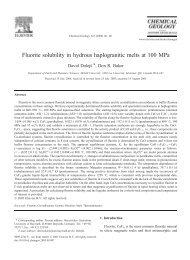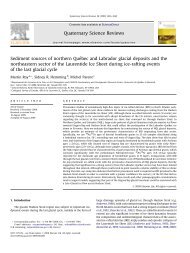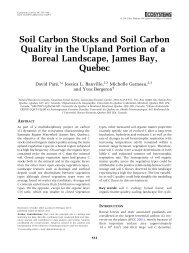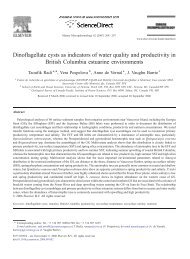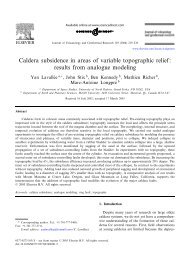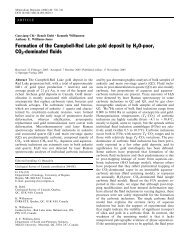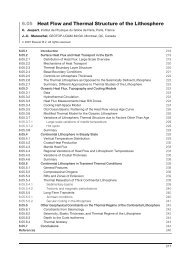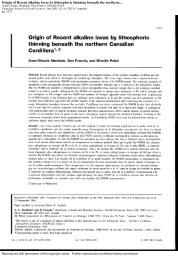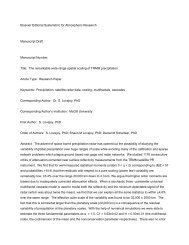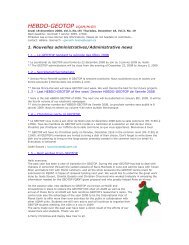A pervasive link between Antarctic ice core and subarctic Pacific ...
A pervasive link between Antarctic ice core and subarctic Pacific ...
A pervasive link between Antarctic ice core and subarctic Pacific ...
You also want an ePaper? Increase the reach of your titles
YUMPU automatically turns print PDFs into web optimized ePapers that Google loves.
S.L. Jaccard et al. / Quaternary Science Reviews 29 (2010) 206–212 211<br />
by the Subarctic North <strong>Pacific</strong> (Jaccard et al., 2005; Gebhardt<br />
et al., 2008).<br />
The extended ODP 882 Ba/Al record shows reduced amplitude<br />
of interglacial maxima during MIS 13–17, that is reminiscent of the<br />
reduction in amplitude of the dD <strong>and</strong> CO 2 records (Fig. 2). Interglacial-glacial<br />
amplitude variability in the EDC dD, CO 2 <strong>and</strong> ODP<br />
882 Ba/Al records show strong correlations (Fig. 4), further<br />
emphasizing that <strong>Antarctic</strong> air temperature, global atmospheric<br />
CO 2 <strong>and</strong> <strong>subarctic</strong> <strong>Pacific</strong> export production are mechanistically<br />
<strong>link</strong>ed. The apparent implication is that whatever caused the luke<br />
warm interglacials to be relatively cool was <strong>link</strong>ed to marine<br />
biogeochemistry in a roughly linear fashion. Presumably this<br />
resulted from some combination of two things: (1) a straightforward<br />
physical climate control of the marine ecosystem, likely<br />
through modulation of the nutrient supply, or (2) to a straightforward<br />
oceanic control on climate, such as through modulation of<br />
atmospheric CO 2 . For example, given the significant dependency of<br />
polar ocean water-column stability on the mean ocean temperature<br />
(de Boer et al., 2007; Winton, 1997), upwelling of nutrient-rich<br />
deep waters to the <strong>subarctic</strong> <strong>Pacific</strong> (<strong>and</strong> possibly to the <strong>Antarctic</strong><br />
Zone of the Southern Ocean) surface waters could have been<br />
reduced as a direct result of ocean temperature. Wind-driven<br />
mechanisms are also being considered as an explanation for the<br />
reduced <strong>Antarctic</strong> <strong>and</strong> Subarctic North <strong>Pacific</strong> vertical exchange<br />
during <strong>ice</strong> ages (Toggweiler et al., 2006). It remains to be seen<br />
whether such mechanisms could similarly explain the ‘‘mid-way’’<br />
state of North <strong>Pacific</strong> export production during the ‘‘luke-warm’’<br />
interglacials.<br />
5. Conclusion<br />
Sedimentary measurements of Ba/Al from the NW <strong>subarctic</strong><br />
<strong>Pacific</strong> show a <strong>pervasive</strong> <strong>link</strong> to <strong>Antarctic</strong> <strong>ice</strong>-<strong>core</strong> dD (Jouzel et al.,<br />
2007) <strong>and</strong> CO 2 records (Lüthi et al., 2008; Monnin et al., 2001; Petit<br />
et al., 1999; Siegenthaler et al., 2005). The compelling decrease in<br />
amplitude observed in EDC dD, CO 2 <strong>and</strong> ODP 882 Ba/Al during the<br />
‘‘luke-warm’’ interglacials MIS 13, 15 & 17 adds further support for<br />
the apparent climate/North <strong>Pacific</strong> biogeochemistry connection.<br />
Our preferred interpretation is that the export flux from the surface<br />
was significantly reduced during peak <strong>ice</strong> ages when compared to<br />
warmer interglacial intervals, although the preservation of organic<br />
carbon in the seafloor sediments was enhanced during glacials due<br />
to some combination of low temperatures (Matsumoto, 2007), low<br />
oxygen concentrations, <strong>and</strong> high clay concentrations. Increased<br />
dust flux during glacial periods is likely to have further contributed<br />
to low Ba/Al during these intervals. Sea surface temperature<br />
reconstructions (Gebhardt et al., 2008; Haug, 1996; Kiefer et al.,<br />
2001; Kiefer <strong>and</strong> Kienast, 2005) corroborated by micropaleontological<br />
evidence (Sancetta <strong>and</strong> Silvestri, 1986) have shown that the<br />
open <strong>subarctic</strong> <strong>Pacific</strong> was far from freezing during glacial maxima.<br />
Sea <strong>ice</strong> cover is thus unlikely to have represented a major limitation<br />
on the productive season during glacial times. The most reasonable<br />
mechanism for reducing export productivity is a decrease in the<br />
supply of nutrients from subsurface waters. Reconstruction of the<br />
degree of nitrate utilization nitrate using the N isotopes (Brunelle<br />
et al., 2007; Galbraith et al., 2008) suggests that the <strong>subarctic</strong> <strong>Pacific</strong><br />
biological pump was more efficient during <strong>ice</strong> ages. Thus, it may<br />
have contributed significantly to increased deep ocean sequestration<br />
of carbon during <strong>ice</strong> ages.<br />
Acknowledgements<br />
This research used samples provided by the Ocean Drilling<br />
Program (ODP). ODP is sponsored by the U.S. National Science<br />
Foundation (NSF) <strong>and</strong> participating countries under the<br />
management of Joint Oceanographic Institutions (JOI), Inc. We<br />
thank C. Murray-Wallace as well as two anonymous reviewers for<br />
insightful <strong>and</strong> constructive comments.<br />
References<br />
Altabet, M.A., François, R., 1994. Sedimentary nitrogen isotopic ratio as a recorder for<br />
surface ocean nitrate utilization. Global Biogeochemical Cycles 8 (1), 103–116.<br />
Anderson, R.F., Chase, Z., Fleisher, M.Q., Sachs, J.P., 2002. The southern ocean’s<br />
biological pump during the last glacial maximum. Deep-Sea Research II 49,<br />
1909–1938.<br />
Broecker, W.S., 1982. Glacial to interglacial changes in ocean chemistry. Progress in<br />
Oceanography 2, 151–197.<br />
Broecker, W.S., Peng, T.H., 1985. The role of CaCO 3 compensation in the glacial to<br />
interglacial atmospheric CO 2 change. Global Biogeochemical Cycles 1, 15–29.<br />
Brunelle, B.G., et al., 2007. Evidence from diatom-bound nitrogen isotopes for<br />
<strong>subarctic</strong> <strong>Pacific</strong> stratification during the last <strong>ice</strong> age <strong>and</strong> a <strong>link</strong> to North <strong>Pacific</strong><br />
denitrification changes. Paleoceanography 22 doi:1029/2005PA001205.<br />
de Boer, A.M., Sigman, D.M., Toggweiler, J.R., Russell, J.L., 2007. Effect of global ocean<br />
temperature change on deep ocean ventilation. Paleoceanography 22.<br />
doi:10.1029/2005PA001242.<br />
Conkright, M.E., et al., 2002. World Ocean Atlas 2001: Objective Analysis, Data Statistics<br />
<strong>and</strong> Figures, CD-ROM. National Oceanographic Data Center, Silver Spring.<br />
Climap Members, 1981. In: Cline, R. (Ed.), Maps of Northern <strong>and</strong> Southern Hemisphere<br />
Continental Ice, Sea Ice, <strong>and</strong> Sea Surface Temperatures in August for the<br />
Modern <strong>and</strong> the Last Glacial Maximum. Geological Society of America Map <strong>and</strong><br />
Chart Series.<br />
Dymond, J., Suess, E., Lyle, M., 1992. Barium in deep-sea sediments: a geochemical<br />
proxy for paleoproductivity. Paleoceanography 7 (2), 163–181.<br />
Eagle, M., Paytan, A., Arrigo, K.R., van Dijken, G., Murray, R.W., 2003. A comparison<br />
<strong>between</strong> excess barium <strong>and</strong> barite as indicators of carbon export. Paleoceanography<br />
18. doi:10.1029/2002PA000793.<br />
Emile-Geay, J., et al., 2003. Warren revisited: atmospheric freshwater fluxes <strong>and</strong><br />
why is no deep water formed in the North <strong>Pacific</strong>. Journal of Geophysical<br />
Research 108. doi:10.1029/2001JC001058.<br />
François, R., et al., 1997. Contribution of Southern Ocean surface-water stratification<br />
to low atmospheric CO 2 concentrations during the last glacial period. Nature<br />
389, 929–935.<br />
François, R., Honjo, S., Manganini, S.J., Ravizza, G.E., 1995. Biogenic barium to the<br />
deep sea: implications for paleoproductivity reconstruction. Global Biogeochemical<br />
Cycles 9 (2), 289–303.<br />
Galbraith, E.D., et al., 2007. Carbon dioxide release from the North <strong>Pacific</strong> abyss<br />
during the last deglaciation. Nature, 890–894.<br />
Galbraith, E.D., et al., 2008. Consistent relationship <strong>between</strong> global climate <strong>and</strong><br />
surface nitrate utilization in the western Subarctic <strong>Pacific</strong> throughout the last<br />
500 ky. Paleoceanography 23. doi:10.1029/2007PA001518.<br />
Ganeshram, R.S., François, R., Commeau, J., Brown-Leger, S.L., 2003. An experimental<br />
investigation of barite formation in seawater. Geochimica et Cosmochimica Acta<br />
67 (14), 2599–2605.<br />
Gargett, A.E., 1991. Physical processes <strong>and</strong> the maintenance of nutrient-rich<br />
euphotic zones. Limnology <strong>and</strong> Oceanography 36, 1527–1546.<br />
Gebhardt, H., et al., 2008. Paleonutrient <strong>and</strong> productivity records from the <strong>subarctic</strong><br />
North <strong>Pacific</strong> for Pleistocene terminations I to V. Paleoceanography 23.<br />
doi:10.1029/2007PA001513.<br />
Goldberg, E.D., Arrhenius, G.O.S., 1958. Chemistry of <strong>Pacific</strong> pelagic sediments.<br />
Geochimica et Cosmochimica Acta 13, 153–212.<br />
Gorbarenko, S.A., 1996. Stable isotope <strong>and</strong> lithologic evidence of late-glacial <strong>and</strong><br />
holocene oceanography of the northwestern <strong>Pacific</strong> <strong>and</strong> its marginal seas.<br />
Quaternary Research 46, 230–251.<br />
Hartnett, H.E., Keil, R.G., Hedges, J.I., Devol, A.H., 1998. Influence of oxyge exposure<br />
time on organic carbon preservation in continental margin sediments. Nature<br />
391, 572–574.<br />
Haug, G.H., 1996. Zur Paläo-Ozeanographie und Sedimentationsgeschichte im<br />
Nordwest-Pazifik während der letzten 6 Millionen Jahre (ODP-Site 882), p. 78.<br />
Univ. Kiel, Kiel.<br />
Haug, G.H., Maslin, M.A., Sarnthein, M., Stax, R., Tiedemann, R., 1995. Evolution of<br />
northwest <strong>Pacific</strong> sedimentation patterns since 6 Ma (Site 882). In: Rea, D.K.,<br />
Basov, I.A., Scholl, D.W., Allan, J.F. (Eds.), Proceedings of the Ocean Drilling Program.<br />
Scientific Results. Ocean Drilling Program, College Station, TX, pp. 293–314.<br />
Hedges, J.I., et al., 1999. Sedimentary organic matter preservation: a test for selective<br />
degradation under oxic conditions. American Journal of Science 299, 529–555.<br />
Honda, M.C., et al., 2002. The biological pump in the northwestern North <strong>Pacific</strong><br />
based on fluxes <strong>and</strong> major components of particulate matter obtained by<br />
sediment-trap experiments (1997–2000). Deep-Sea Research II 49, 5595–5625.<br />
Ito, T., Follows, M.J., 2005. Preformed phosphate, soft tissue pump <strong>and</strong> atmospheric<br />
CO 2 . Journal of Marine Research 63, 813–839.<br />
Jaccard, S.L., et al., 2009. Subarctic <strong>Pacific</strong> evidence for a glacial deepening of the<br />
oceanic respired carbon pool. Earth <strong>and</strong> Planetary Science Letters 277, 156–165.<br />
Jaccard, S.L., et al., 2005. Glacial/interglacial changes in <strong>subarctic</strong> North <strong>Pacific</strong><br />
stratification. Science 308, 1003–1006.<br />
Jouzel, J., et al., 2007. Orbital <strong>and</strong> millenial antarctic climate variability over the past<br />
800,000 years. Science 317, 793–796.



